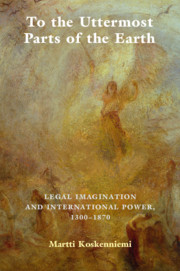Book contents
- To the Uttermost Parts of the Earth
- To the Uttermost Parts of the Earth
- Copyright page
- Dedication
- Contents
- Acknowledgements
- Introduction
- Part I Towards the Rule of Law
- Part II France: Law, Sovereignty and Revolution
- Part III Britain: Laws and Markets
- 8 The Law and Economics of State-Building
- 9 “Giving Law to the World”
- 10 Global Law
- Part IV Germany: Law, Government, Freedom
- Bibliography
- Index
8 - The Law and Economics of State-Building
England c. 1450–c. 1650
from Part III - Britain: Laws and Markets
Published online by Cambridge University Press: 05 August 2021
- To the Uttermost Parts of the Earth
- To the Uttermost Parts of the Earth
- Copyright page
- Dedication
- Contents
- Acknowledgements
- Introduction
- Part I Towards the Rule of Law
- Part II France: Law, Sovereignty and Revolution
- Part III Britain: Laws and Markets
- 8 The Law and Economics of State-Building
- 9 “Giving Law to the World”
- 10 Global Law
- Part IV Germany: Law, Government, Freedom
- Bibliography
- Index
Summary
The emergence of the English state in the 16th and 17th centuries was underwritten by two rival legal vocabularies: royal prerogative and the common law. These opened the two avenues through which successive Tudor and Stuart rulers tried to integrate the landowning nobility and the merchant elites in support of the crown’s policies. Each vocabulary had its biases. Prerogative powers were articulated by civilians whose Roman law training made them almost automatic supporters of absolutism. Common lawyers, by contrast, stressed the inviolability of the rights of property against the extractions of the king. Both idioms had their view also on the law of nations. Civilians focused on diplomacy and the rules of war and peace while common lawyers understood property as a natural right to wage commerce across the world. Sometimes the vocabularies came together as a specific lex mercatoria. A series of legal cases in the 17th century juxtaposed sovereignty and property rights in a way that inspired Thomas Hobbes to produce his powerful theory of the commonwealth as a protection/obedience pact in which all property rights were dependent on the decision of the sovereign.
- Type
- Chapter
- Information
- To the Uttermost Parts of the EarthLegal Imagination and International Power 1300–1870, pp. 561 - 621Publisher: Cambridge University PressPrint publication year: 2021



